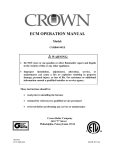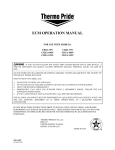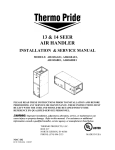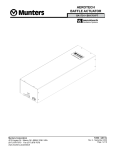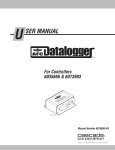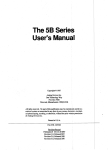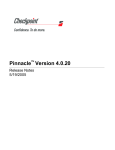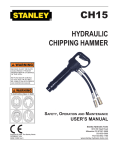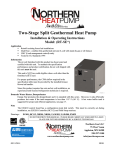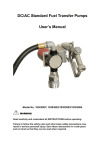Download 13 & 14 SEER AIR HANDLER - All American Modular Inc
Transcript
13 & 14 SEER AIR HANDLER INSTALLATION & SERVICE MANUAL MODELS: AH2436E1, AH4260E1 PLEASE READ THESE INSTRUCTIONS PRIOR TO INSTALLATION AND BEFORE PERFORMING ANY SERVICE OR MAINTENANCE. THESE INSTRUCTIONS MUST BE LEFT WITH THE USER AND SHOULD BE RETAINED FOR FUTURE REFERENCE BY QUALIFIED SERVICE PERSONNEL. : Improper installation, adjustment, alteration, service, or maintenance can cause injury or property damage. Refer to this manual. For assistance or additional information consult a qualified installer, service agency, or manufacturer listed below. THERMO PRODUCTS, LLC. BOX 217 NORTH JUDSON, IN 46366 PHONE: (574) 896-2133 MAC-183 ECN 4849-MA MADE IN USA TABLE OF CONTENTS SECTION BEGINNING PAGE SAFETY SECTION 1 KNOCKDOWN OF AIR HANDLER 2 REASSEMBLY OF AIR HANDLER 3 SETTING UP THE A-COIL FOR AIR CONDITIONING 3 INSTALLATION OF HOT WATER COIL 4 BLOWER AIR ADJUSTMENT 6 DUCT SYSTEM 9 DUCT SIZING CHART 10 INDOOR EVAPORATOR COIL 10 TUBING LINE SETS 10 HOW TO MEASURE LIQUID SUB-COOLING 14 MEASURING TEMPERATURE DROP ACROSS THE “A” COIL 15 ELECTRICAL 15 UA ADAPTER CABINET 16 RECOMMENDED SUSPENSION PROCEDURE FOR AH AIR HANDLER 16 ECM TROUBLE SHOOTING 17 TROUBLE SHOOTING CHARTS 20 SEQUENCE OF OPERATION 21 REPLACEMENT PARTS LIST 23 All installations and services must be performed by qualified personnel. SAFETY SECTION This page contains various warnings and cautions found throughout this Service and Installation Manual. Please read and comply with the statements on the cover and the statements below. : Improper installation, adjustment, alteration, service, or maintenance can cause injury or property damage. Refer to this manual. For assistance or additional information consult a qualified installer, service agency, or manufacturer listed below. : If drilling or screwing into panel or plate is necessary, make certain drill or screw does not penetrate into any part of evaporator coil or hot water coil and cause damage. Personal injury and/or property damage may result. : Do not use this system if any part has been under water. Immediately call a qualified service agency to inspect the system and to replace any part of the electrical or control system which has been under water. : The cooling and heating coils must be cleaned by a qualified service person. : This air handler is not to be used to condition during construction. : When testing electrical equipment, always follow standard electrical procedures and precautions. : DO NOT wet electronic components during hydronic testing. Wetting electronic components may damage circuitry and cause a hazardous situation. Dry moisture from all leads and terminals if wetting occurs. Wait at least 24 hours for the circuit to fully dry before energizing the system. : Personal injury or property damage could result from major repair or service of this system by anyone other than a qualified contractor. : If you do not follow these instructions exactly an unsafe condition may result causing personal injury, loss of life or property damage. Installation and service personnel are required by some states to be licensed. Persons not qualified shall not install this equipment nor interpret these instructions. All local codes and regulations take precedence over the instructions in this manual and should be followed accordingly. In the absence of local codes, installation must conform with these instructions, regulations of the National Fire Protection Association and provisions of the National Electric Code. 1 All installations and services must be performed by qualified personnel. AIR HANDLER Each air handler is shipped with an evaporator preinstalled. The AH2435E1 is shipped with a 12U2430AG15 evaporator coil for 2 to 3 ton operation. The AH4260E1is shipped with a 12U3648AG17 evaporator coil for 3 to 5 ton operation. The construction of the air handler permits easy knockdown and reassembly. See Figure A. Figure A. FOLLOW THESE STEPS FOR KNOCKDOWN OF AIR HANDLER: 1. Start with unit setting in a vertical position(Figure A). 2. Remove middle door. 3. Remove screws from bottom door, top door, and top front panel. Remove doors and top panel of air handler. 4. Remove the retention clip from in front of the A-coil drain pan and the horizontal drain pan shipping screw(s) from the right side casing. 5. Remove the A-coil assembly. 6. Disconnect power leads and unplug circulation pump connector from the blower control board. 2 All installations and services must be performed by qualified personnel. 7. Remove the screws that secure the blower assembly to the blower pan and pull blower sub-assembly out the front of the unit. 8. Remove screws that secure the blower pan to the side & back casings. 9. Push the front edges of the side casings slightly apart and remove the blower pan. 10. Remove screws from the bottom and the casing back. 11. Remove casing back and side casings from the bottom. REASSEMBLY OF AIR HANDLER To reassemble the air handler, reverse steps above starting with number 10. SETTING UP THE A-COIL FOR AIR CONDITIONING The AH2436E1 & AH4260E1 come with the A-coil pre-installed for vertical and left to right horizontal airflow. IMPORTANT: When air handler is installed in attic above a finished ceiling, it is recommended that a safety overflow pan with its own separate drain be installed under the entire unit. For a right to left horizontal air flow the following steps 1-8 must be followed. Otherwise skip to step 9. Reversing the horizontal orientation 1. Remove the middle door of the air handler. 2. Remove the bottom door of the air handler. 3. Remove the retention clip from in front of the A-coil drain pan. 4. Remove the horizontal drain pan shipping screw(s) from the right side casing. 5. Remove the A-coil assembly and slip the horizontal drain pan assembly off of the right side of the Acoil. 5a. Remove the bottom right side support L-bracket and remount in the left hand position using the prepunched holes for a guide. 6. Slip the horizontal drain pan assembly onto the left side of the A-coil. 7. Replace the A-coil assembly into the air handler. The A-coil drain pan should slide under the rear retention clip. The horizontal drain pan assemble should rest against the right panel insulation and the bottom side support. 8. Replace the retention clip for the front of the evaporator drain pan. For all orientations 9. Cut open the appropriate drain pan drain access hole in the bottom door. 10. Slip the Suction line grommet panel over the suction line up to the bottom door surface. 3 All installations and services must be performed by qualified personnel. Figure B 11. Make appropriate liquid and suction line connections to coil and braze connections. NOTE: A wet rag makes an excellent heat sink for tubing and grommets. : If drilling or screwing into panel of plate is necessary, make certain drill does not penetrate into any part of evaporator coil or hot water coil to avoid personal injury and/or property damage. 13. Position grommet panel on bottom door surface and secure in place with screws. Refer to Figure B. 14. Make appropriate condensate drain connections and seal the access opening. INSTALLATION OF THE HOT WATER COIL: 1. Remove top door of air handler. 2. Slide hot water coil's side hanger brackets into coil channel(retaining channel) in the air handler. See Figure C. 3. Push coil into unit until the coil is stopped by the back casing. 4. Cut out appropriate holes in insulation, realign top door and secure into place. 5. Make appropriate hydronic connections to inlet(blower side) and outlet(duct side) of coil and braze into place. 6. Seal connections through panel with duct sealer or equivalent. 4 All installations and services must be performed by qualified personnel. Figure C : If drilling or screwing into panel or plate is necessary, make certain drill does not penetrate into any part of evaporator coil or hot water coil. Personal injury and/or property damage may result. Figure D NOTE: Drain lines must be pitched no less than 1/4" per foot away from the air handler. 5 All installations and services must be performed by qualified personnel. BLOWER AIR ADJUSTMENT The ECM blower control must be set in order to establish proper air movement. Use the following steps to do this: 1. Identify to tonnage of the condensing unit that will be used. 2. If Hydronic heat is to be used, identify your BTU heat requirements, preferred supply air temperature, water temperature and water flow through the coil in gallons per minute. 3. Locate the blower control board mounted to the front of the blower assembly. 4. Locate the red switch block labeled SW1 for adjusting the Heating and Cooling blower speed. 5. Locate SW2, just below SW1, for adjusting Blower delays. Figure E BLOWER COOLING SPEEDS Refer Table C1 for setting switches 4, 5 & 6 for the A/C sizing. Table C1 COOLING SWITCH SETTINGS A/C TONS CFM AH2436E1 COOL Settings (SW1) 4 5 6 OFF OFF OFF OFF OFF ON OFF OFF ON AH4260E1 COOL Settings (SW1) 4 5 6 800 1000 1200 OFF 1400 ON 1600 OFF 1800 ON 5 2000 OFF 2200 ON Shaded cells represent the factory settings 2 2-1/2 3 3-1/2 4 ON ON OFF OFF ON ON OFF OFF ON ON ON ON BLOWER HEATING SPEEDS In the next two pages: 1. Locate the page that refers to the Air Handler to be set up. 2. Find the line(s) on the chart that best represents the water temperature and gallons per minute available. 3. Find the point along the curve that best fits the BTU and Supply Air temperature desired. 4. Read the letter associated with that point and use it to find the switch settings in the table below the chart. (The table below the switch settings represent the actual numbers represented by the chart.) 6 All installations and services must be performed by qualified personnel. AH2436E1 Temperature & Heat Values at 140,160&180°F and 3,4,5&6 gallons per minute at selected speeds Supply Air w/70º Return (ºF) 145 A B C D 135 E F G H 125 7gpm:180° 6gpm 5gpm 4gpm 3gpm 7gpm:160° 6gpm 5gpm 4gpm 3gpm 7gpm:140° 6gpm 5gpm 4gpm 3gpm 115 105 95 25 35 45 55 65 75 Heat Capacity (KBTU/H) SPEED CFM A B C D E F G H 689 754 819 897 975 1066 1170 1300 Water Temperature Flow 7gpm 6gpm 180°F H2O 5gpm 4gpm 3gpm 7gpm 6gpm 160°F H2O 5gpm 4gpm 3gpm 7gpm 6gpm 140°F H2O 5gpm 4gpm 3gpm HEAT Settings (SW1) 1 2 OFF OFF ON OFF ON OFF ON ON OFF OFF ON OFF ON OFF ON ON 3 OFF OFF OFF OFF ON ON ON ON CFM 689 (A) 754 (B) 819 (C) 897 (D) 975 (E) 1066 (F) 1170 (G) 1300 (H) Supply Air (°F) Heat (Kbtu/H) Supply Air (°F) Heat (Kbtu/H) Supply Air (°F) Heat (Kbtu/H) Supply Air (°F) Heat (Kbtu/H) Supply Air (°F) Heat (Kbtu/H) 144° 55 142° 54 141° 53 138° 51 135° 49 141° 58 140° 57 138° 56 136° 54 132° 51 138° 61 137° 60 135° 58 133° 56 129° 53 136° 64 134° 63 133° 61 130° 58 126° 55 133° 67 132° 65 130° 63 127° 61 124° 57 130° 70 129° 68 127° 66 125° 63 121° 59 128° 73 126° 71 124° 69 122° 66 118° 61 124° 77 123° 75 121° 72 119° 69 115° 63 Supply Air (°F) Heat (Kbtu/H) Supply Air (°F) Heat (Kbtu/H) Supply Air (°F) Heat (Kbtu/H) Supply Air (°F) Heat (Kbtu/H) Supply Air (°F) Heat (Kbtu/H) 130° 45 129° 44 128° 43 126° 42 123° 40 128° 47 127° 46 125° 45 123° 44 120° 41 126° 50 125° 49 123° 47 121° 46 118° 43 123° 52 122° 51 121° 50 119° 48 116° 45 121° 54 120° 53 119° 52 117° 49 114° 46 119° 57 118° 56 117° 54 115° 51 111° 48 117° 60 116° 58 114° 56 112° 54 109° 50 114° 63 113° 61 112° 59 110° 56 107° 52 Supply Air (°F) Heat (Kbtu/H) Supply Air (°F) Heat (Kbtu/H) Supply Air (°F) Heat (Kbtu/H) Supply Air (°F) Heat (Kbtu/H) Supply Air (°F) Heat (Kbtu/H) 117° 35 116° 34 115° 33 113° 32 111° 31 115° 37 114° 36 113° 35 111° 34 109° 32 113° 38 112° 38 111° 37 110° 35 107° 33 111° 40 111° 39 109° 38 108° 37 105° 34 110° 42 109° 41 108° 40 106° 38 104° 36 108° 44 107° 43 106° 42 104° 40 102° 37 106° 46 105° 45 104° 43 103° 41 100° 38 104° 48 103° 47 102° 46 101° 43 98° 40 7 All installations and services must be performed by qualified personnel. AH4260E1 Temperature & Heat Values at 140,160&180°F and 7,8,9&10 gallons per minute at selected speeds Supply Air w/70º Return (ºF) 150 A B C D 140 E F G H 130 10gpm:180° 9gpm 8gpm 7gpm 10gpm:160° 9gpm 8gpm 7gpm 10gpm:140° 9gpm 8gpm 7gpm 120 110 100 40 60 80 100 120 Heat Capacity (KBTU/H) SPEED CFM A B C D E F G H 1007 1102 1197 1311 1425 1558 1710 1900 Water Temperature Flow 10gpm 9gpm 180°F H2O 8gpm 7gpm 10gpm 9gpm 160°F H2O 8gpm 7gpm 10gpm 9gpm 140°F H2O 8gpm 7gpm HEAT Settings (SW1) 1 2 OFF OFF ON OFF ON OFF ON ON OFF OFF ON OFF OFF ON ON ON 3 OFF OFF OFF OFF ON ON ON ON CFM 1007 (A) 1102 (B) 1197 (C) 1311 (D) 1425 (E) 1558 (F) 1710 (G) 1900 (H) Supply Air (°F) Heat (Kbtu/H) Supply Air (°F) Heat (Kbtu/H) Supply Air (°F) Heat (Kbtu/H) Supply Air (°F) Heat (Kbtu/H) 148° 86 147° 85 146° 83 145° 82 146° 91 145° 90 144° 88 142° 86 144° 96 142° 94 141° 92 139° 90 141° 101 140° 99 138° 97 137° 95 139° 106 137° 104 136° 102 134° 99 136° 112 135° 109 133° 107 131° 104 133° 117 132° 115 130° 112 129° 109 130° 124 129° 121 127° 118 125° 114 Supply Air (°F) Heat (Kbtu/H) Supply Air (°F) Heat (Kbtu/H) Supply Air (°F) Heat (Kbtu/H) Supply Air (°F) Heat (Kbtu/H) 134° 70 133° 69 132° 68 131° 66 132° 74 131° 73 130° 72 129° 70 130° 78 129° 77 128° 75 127° 73 128° 82 127° 81 126° 79 124° 77 126° 86 125° 85 124° 83 122° 81 124° 91 123° 89 121° 87 120° 84 121° 95 120° 94 119° 91 118° 88 119° 101 118° 99 117° 96 115° 93 Supply Air (°F) Heat (Kbtu/H) Supply Air (°F) Heat (Kbtu/H) Supply Air (°F) Heat (Kbtu/H) Supply Air (°F) Heat (Kbtu/H) 119° 54 119° 53 118° 52 117° 51 118° 57 117° 56 116° 55 115° 54 116° 60 116° 59 115° 58 114° 57 115° 64 114° 62 113° 61 112° 60 113° 67 112° 66 111° 64 110° 62 111° 70 111° 69 110° 67 109° 65 110° 74 109° 72 108° 70 107° 68 108° 78 107° 76 106° 74 105° 72 8 All installations and services must be performed by qualified personnel. BLOWER TIME DELAY In cases where the yellow wires are used to start and stop the hydronic pump, SW2 may used to delay when the blower is cycled on or off to increase comfort and efficiency. Use Table D1 to set the switches appropriately Table D1: Delays before blower cycles “ON or “OFF” SW2 Positions 1 2 OFF OFF OFF ON OFF ON ON ON “ON” Delay (Seconds) 30 60 120 480 SW2 Positions 3 4 OFF OFF OFF ON OFF ON ON ON “OFF” Delay (Minutes) 2 4 6 8 DUCT SYSTEM The duct system and load sizing calculation should follow the design standards of Air Conditioning Contractors of America (ACCA) - manuals D & J - or the American Society of Heating, Refrigeration and Air Conditioning Engineers, Inc. (ASHRAE) Latest Edition Fundamentals Volume. To aid you in evaluating existing duct systems quickly, review the chart on Page 11 which shows the CFM capacity for square inch areas, based on .10" wc static pressure (SP) loss on the supply systems. Each of the system's components (trunk lines, take-offs, runs and register and grill-free areas) must be properly sized and matched together to ensure you are obtaining the air handling capacity of the duct system. A 12x8 duct with a 400 CFM capacity, for example, MAY NOT flow 400 CFM if the register(s) to which it connects can only flow a total of 200 CFM. The air handling capacity MUST BE EQUAL TO the supply system at a minimum when sizing the return air duct system. It is recommended to follow design parameters set down by ACCA or ASHRAE on the return air duct systems. 9 All installations and services must be performed by qualified personnel. DUCT SIZES FOR HOMES Velocity Approximately 800 Feet Per Minute THE INDOOR EVAPORATOR COIL 1. EVAPORATOR COIL is a finned coil through which air in the home is circulated. Heat from the air is transferred to the liquid refrigerant inside the evaporator coil. The coils for use in AH air handlers are in an A-shaped configuration (A Models). 2. CONDENSATE DRAIN PAN is attached to the bottom of the evaporator coil to collect water condensed out of the air. Two drain fittings are provided for connection to a convenient drain point. 3. HORIZONTAL CONDENSATE DRAIN PAN is attached to the right side of the first one for horizontal left to right air flow. It may relocated to the left side as well. A drain fitting is provided for connection to a convenient drain point. TUBING LINE SETS 1. SUCTION LINE is an insulated large copper tube connecting the outlet of the A/C evaporator to the suction inlet of the A/C CONDENSER. 10 All installations and services must be performed by qualified personnel. 2. LIQUID LINE is a single small tube connecting the outlet of the A/C condenser to the expansion valve inlet on the A/C evaporator coil. TUBING SIZE REFERENCE CHART Tube Diameter for Total Line Length MODEL1 2AC10024-2 2AC10030-2 0-50’ Suction Liquid 3/4” 3/8” 7/8” 3/8” 50-75’ Suction Liquid 3/4” 3/8” 7/8” 3/8” 75-100’ Suction Liquid 3/4” 3/8” 7/8” 1/2” AC1324 & AC1330 AC1424 & AC1430 2AC10036-2, 2AC10042-2, 2AC10048-2 & 2AC10060-2 3/4” 3/8” 7/8” 3/8” 1-1/8” 1/2” AC1336, AC1342, AC1348 & AC1360 AC1336, AC1342, AC1348 & AC1360 7/8” 3/8” 1-1/8” 1/2” 1-1/8” 1/2” 1 It is not recommended to use the AC10 series condensers with these air handlers. The “non-bleed” TXV on the evaporators may cause the condenser to stall during warm weather. NOTES: For line lengths over 25’ adjust charge accordingly per foot of variation from chart. .65 oz. per foot for 3/8” and 3/4” line set .674 oz. per foot for 3/8” and 7/8” line set .694 oz. per foot for 1/2” and 7/8” line set .72 oz. per foot for 1/2” and 1” line set .76 oz. per foot for 5/8” and 1-1/8” line set These charges are to be used in conjunction with a liquid sub-cooling measurement for best performance. 11 All installations and services must be performed by qualified personnel. TUBING INSTALLATION The compressor oil is constantly pumped through the refrigerant lines in normal operation of an air conditioning system. To ensure proper lubrication of the compressor by avoiding oil accumulation at undesirable points in the system, follow the guidelines listed below: 1. No traps in the suction line are necessary if the outdoor condensing unit is level with the indoor evaporator coil or the indoor evaporator coil is 4 feet or less lower then the outdoor condensing unit. Any horizontal runs of suction line should have minimum 1/2" pitch for every 10 feet of line towards the outdoor condensing unit. See Figure F. Figure F. 2. A trap is necessary in the suction line at the indoor evaporator coil if the indoor evaporator coil is more than 4 feet below the outdoor condensing unit. Figure G1. 12 All installations and services must be performed by qualified personnel. NOTE: Multiple suction line traps are recommended for longer or multiple suction lines. See Figure G1. An inverted trap should be installed on the horizontal suction line near the evaporator coil to prevent liquid flood back to the compressor (See Figure G2.) if the indoor evaporator coil is located 10’ or more above the condensing unit. Figure G2. A gradual loop in the tubing can be constructed to take up the excess tubing if you find that too much tubing has been brought onto a job. Such a loop MUST be kept in a horizontal (flat) plane to avoid trapping the oil. Refrigerant lines should be inserted into a suitable conduit or raceway when the lines are to be buried between the building and the outdoor condensing unit. The lines must be provided with sufficient protection and support to prevent damage when installed above ground. When making "on the job" tubing, a solder of 95% tin, 5% antimony or any of the silver solders such as SilFos, Phos-Copper, Easy-Flo 35 or 45, should be used. No attempt will be made here to instruct proper soldering or brazing technique but it is necessary that the installer be properly instructed in accordance with good existing practices. All joints and fittings must be properly leak tested as per EPA guidelines after “on the job” tubing has been made up. The line set and the evaporator coil must be evacuated to 29.96” Hg (1000 microns) or lower when all joints and fittings are leak free. The service valves on the condenser may then be opened to release the refrigerant to the system. Verify proper system performance. See condensing unit manual for additional performance data. 13 All installations and services must be performed by qualified personnel. HOW TO MEASURE LIQUID SUB-COOLING (NOTE: A good electronic thermometer and accurate liquid pressure gauge with a check valve in the Schraeder fitting are necessary). : Failure to use a liquid side hose fitting with a built in check valve may result in personal injury and significant refrigerant loss. Sub-cooling is measured by taking a temperature and pressure reading. See Figure I. The pressure reading is gauged at the pressure port located on the liquid service valve. The temperature reading is taken at the liquid line at the 3:00 o'clock or 9:00 o'clock position with the liquid line as the center of the clock. Figure I. Make sure the tube where the temperature is measured is not in direct sunlight. Read the temperature at the liquid line. Read the liquid pressure. Then convert pressure into temperature. Next, subtract the measured tube temperature from the converted suction temperature. The end result is the liquid sub-cooling. EXAMPLE: Measured Temp = 95oF Measured Pressure = 211PSI which equates to a 105oF saturation temperature. (Listed temperature for measured pressure according to R-22 temperature scale on manifold gauge or R22 section of pressure temperature chart) The difference equals the degrees superheat = 10oF 14 All installations and services must be performed by qualified personnel. A liquid sub-cooling of about 10oF leaving the condenser is good over a wide range of operating conditions for a system with a TXV in the evaporator like the AH2436E1 & AH4260E1. MEASURING TEMPERATURE DROP ACROSS THE “A” COIL: The temperature drop across the coil should be around 18oF to 23oF difference between inlet and outlet air. This should be measured as close to the air handler as possible, to eliminate duct losses. ELECTRICAL All wiring must conform to the provisions of local codes or in the absence of local codes with the provisions of the National Electrical Code, ANSI/NFPA No. 70-Latest Edition and this instruction manual. Equivalent type wire must be used if any of the original wire supplied with the unit needs to be replaced. A 10 amp time delayed fuse or circuit breaker is recommended. NOTE: Condensing unit is not included in above amp rating. 15 All installations and services must be performed by qualified personnel. The following points must be checked by the installer and/or electrician before the air conditioning system is started: 1. Check every electrical connection of "PUSH-ON" or "SCREW-ON" terminals to ensure it is on tightly on its proper post. 2. Review wiring diagram for proper routing. UA ADAPTER CABINET The UA adapter cabinet is designed to be used in conjunction with the AH AIR HANDLER to allow a free standing (vertical discharge) installation. The UA cabinet is shipped completely assembled and ready for installation. The return air opening can face either left or right by exchanging the front filter door and rear filter blockoff assemblies. The AH AIR HANDLER is then placed on the UA adapter cabinet, inlet side down. The UA cabinet is equipped with a permanent washable air filter. AH AIR HANDLER RECOMMENDED SUSPENSION PROCEDURE The detail below is the proper and safest way to suspend the AH. These components should be easily found at your local hardware store. ECM TROUBLE SHOOTING DIAGNOSTC FEATURES 16 All installations and services must be performed by qualified personnel. The control board is equipped with 4 green Input Status LEDs and 1 red Board Status LED. These are intended to provide a quick view into furnace performance without requiring a voltmeter. The green Input Status LEDs are driven by the “Y”, “W”, “G”, and “DEHUM” inputs and are located directly below those inputs. They will light to indicate the presence of these signals. The red Board Status LED has two functions: It will light when the board recognizes a valid input signal and will stay lit until all valid signals are removed. This is intended to show that the board is functioning and able to respond to input signals. It will flash rapidly while120VAC is missing from the LIMIT switch. This is intended to give a quick visual indication of the High LIMIT switch. B. GENERAL GUIDELINES TO TROUBLESHOOTING GE ECM – DRIVEN SYSTEMS : Disconnect power from unit before removing or replacing connectors, or servicing motor. Wait at least 5 minutes after disconnecting power before opening motor. SYMPTOM Motor rocks slightly when starting Motor won’t start • No movement • • • • • • Motor rocks, but won’t start Motor oscillates up & down while being tested off of blower Motor starts, but runs erratically • Varies up and down or intermittent • • • • • • • • • • • • “Hunts” or “puffs” at high CFM (speed) • • • • Stays at low CFM despite system call for cool or heat CFM • • • Stays at high CFM • • • • 17 CAUSE/PROCEDURE This is normal start-up for ECM Check power at motor Check low voltage (24 VAC R to C) at motor Check low voltage connections (G,PWM,W,R,C,) at motor Check for unseated pins in connectors on motor harness Test with a temporary jumper between R – G Check motor for tight shaft Perform motor/control replacement check Run Moisture Check Check for loose or compliant motor mount Make sure blower wheel is tight on shaft Perform motor/control replacement check It is normal for motor to oscillate with no load on shaft. Check line voltage for variation or “sag” Check low voltage connections (G,PWM,W,R,C,) at motor, unseated pins in motor harness connectors Check “Bk” for erratic CFM command (in variable speed applications) Check-out system controls – T’stat? Perform Moisture Check Does removing panel or filter reduce “puffing”? Reduce restriction Reduce max airflow Check low voltage (T’stat) wires and connections Verify fan is not in delay mode – wait until delay complete “R” missing/not connected at motor Perform motor/control replacement check “R” missing/not connected at motor Is fan in delay mode? – wait until delay time All installations and services must be performed by qualified personnel. • Blower won’t shut off • • Excessive noise • • Noisy blower or cabinet • • • “Hunts” or “puffs” at high CFM (speed) • Evidence of Moisture • Motor failure or malfunction has occurred and moisture is present • Evidence of moisture present inside air mover • • • • • • DO Check-out motor, controls, wiring and connections thoroughly before replacing motor Orient connectors down so water can’t get in Install “drip loops” Use authorized motor and control model #’s for replacement Keep static pressure to a minimum: Recommend high efficiency, low static filters Recommend keeping filters clean Design ductwork for min static, max comfort Look for and recommend ductwork improvement, where necessary, in replacement Size the equipment wisely Check orientation before inserting motor connectors complete Perform motor/control replacement check Current leakage from controls into G,Y or W? Check for Triac switched t’stat or solid state relay Determine if it’s air noise, cabinet, duct or motor noise – interview customer, if necessary Check for loose blower housing, panels, etc. High static creating high blower speed? Check for air whistling thru seams in ducts, cabinets or panels Check for cabinet/duct deformation Does removing panel or filter reduce “puffing”? Reduce restriction Reduce max airflow • Replace motor and perform Moisture Check • Perform Moisture Check • DON’T Automatically assume the motor is bad. • • • • • • • Locate connectors above 7 and 4 o’clock positions Replace one motor or control model # with another (unless an authorized replacement) Use high pressure drop filters – some have ½” H2O drop! Use restricted returns Oversize system then compensate with low airflow Plug in power connector backwards Force plugs Moisture Check • Connectors are orientated “down” (or as recommended by equipment manufacturer) • Arrange harnesses with “drip loop” under motor • Is condensate drain plugged? • Check for low airflow (too much latent capacity) • Check for undercharged condition • Check and plug leaks in return ducts, cabinet Comfort Check • Check proper airflow settings 18 All installations and services must be performed by qualified personnel. • • • Low static pressure for lowest noise Set low continuous-fan CFM T’stat in bad location? Figure K: ECM PIN CONNECTORS Troubleshooting table above and Figure K adapted from GE Industrial Systems publication GED-7161C, “Troubleshooting GE ECM – Driven Systems”. 19 All installations and services must be performed by qualified personnel. TROUBLESHOOTING CHARTS THIS GUIDE SHOULD BE USED IN THE CASE OF A STOPPED OR MANFUNCTIONED ECM BLOWER MOTOR. THE FOLLOWING SHOULD HELP ESTABLISH THE TYPE OF MALFUNCTION OR DEVIATION FROM THE NORMAL BLOWER OPERATION. TO USE THIS DIAGRAM, YOU JUST NEED TO FOLLOW THE INSTRUCTIONS IN THE BOXES. CONFIRM IF EITHER BLOWER WHEEL IS RUBBING AGAINST HOUSING OR MOTOR SHAFT IS SPINNING FREELY, REPAIR OR REPLACE AS NECESSARY. NO DOES BLOWER SPIN FREELY? YES IS THERE 115V SUPPLIED TO MOTOR? CHECK 115V SUPPLY, CONNECTION FUSES, SERVICE SWITCH AND DOOR SWITCH. NO YES DISCONNECT 16 PIN HARNESS FROM MOTOR. IS THERE 12VDC ACROSS PIN12 & PIN1 AND PIN12 & PIN3 AT THE HARNESS PLUG? IS THERE 24VAC ACROSS R & B/C ON THE INTEGRATED CONTROL? NO NO CHECK 24VAC SUPPLY TO INTEGRATED CONTROL. NO REPLACE INTEGRATED CONTROL. YES DISCONNECT 16PIN HARNESS FROM INTEGRATED CONTROL. IS THERE 12VDC ACROSS YES PIN 6 & PIN 1 AT THE CONROL? YES CHECK HARNESS CONNECTIONS AND WIRE. TURN THERMOSTAT MANUAL FAN SWITCH ON (IF AVAILABLE) OR JUMPER BETWEEN R & G ON INTEGRATED CONTROL. IS THERE VOLTAGE GREATER THAN 12VDC BETWEEN PIN15 & PIN1? NO YES CHECK CONNECTION ON HARNESS AND MOTOR, RECONNECT HARNESS TO MOTOR, IF CONNECTIONS ARE GOOD AND MOTOR STILL DOES NOT RUN REPLACE MOTOR. 20 CHECK CONNECTIONS AND WIRES AT INTEGRATED CONTROL, IF OK REPLACE INTEGRATED CONTROL. All installations and services must be performed by qualified personnel. Yes Sequence of Operation BLOWER OffDelay Active? No Yes HEAT Mode On? Yes W Active? No Yes On-Delay Ended? N Yes LIMIT Active? No No 1.BURNER Off 2. HEAT mode Off 3. BLOWER Off-Delay Started 4. Status LED Off BURNER On Yes Yes COOL Mode On? No Yes Y Active? Yes On-Delay Ended? No DEHUM Active? No No 1. A/C Off 2. COOL mode Off 3.BLOWER Off-Delay Started 4. Status LED Off FAN Mode On? Yes No G Active? BLOWER = COOL Yes BLOWER = LOW No 1. BLOWER Off (No Delay) 2. Status LED Off Yes LIMIT Active? 1. HEAT mode On 2. BLOWER = HEAT 3. Status LED Flashes No W Active? Yes 1. HEAT mode On 2. Blower On-Delay Started 3. Burner On 4. Status LED On (continuous) No Y Active? Yes 1. COOL mode On 2. Blower On-Delay Started 3. Condenser On 4. Status LED On (continuous) No G Active? Yes 1. FAN mode On 2. BLOWER = LOW 3. Status LED On (continuous) No 21 BLOWER = LOW All installations and services must be performed by qualified personnel. Sequence of Operation Glossary Inputs: LIMIT - 120vac power from the High Limit Switch used to power the burner. W- Switched 24vac indicating a Heat call from the thermostat. Y - Switched 24vac indicating a Cool call from the thermostat. G - Switched 24vac indicating a call for blower operation from the thermostat. DEHUM - Switched 24vac indicating a call for Dehumidification from a de-humidistat. 2 Stage Control Inputs: LIMIT - 120vac power from the High Limit Switch used to power the burner. W1- Switched 24vac indicating a Heat call from the thermostat. (Low fire) W2- Switched 24vac indicating a Heat call from the thermostat. (High fire) Y - Switched 24vac indicating a Cool call from the thermostat. G - Switched 24vac indicating a call for blower operation from the thermostat. DEHUM - Switched 24vac indicating a call for Dehumidification from a de-humidistat. NOTE: 2-Stage T-stat W1 – Low Fire W2 – High Fire Connect 2-Stage T-stat to both W1 and W2. Single Stage T-stat W2 Connect single stage T-stat to W2 only. BLOWER Speeds: HEAT - The Heating Blower speed selected by positions 1, 2 & 3 of SW1 (CFM tables on page 4) COOL - The Cooling Blower speed selected by positions 4, 5 & 6 of SW1 (CFM tables on page 4) LOW - The LOW Blower speed selected by positions 4, 5 & 6 of SW1 (CFM tables on page 4) ECM – PSC Replacement In an emergency situation, a defective ECM motor can be replace with a PSC motor to provide temporary circulating air flow for heating or cooling. This is done by replacing the ECM motor in the motor mounting bracket with a PSC motor of similar Horsepower. Wire the common lead (typically white) of the replacement PSC motor to the neutral (common) terminal on the fan control board (N - 1 through 7). Connect the high-speed replacement PSC motor lead (typically black) to the EAC terminal on the fan control board. The EAC contact is energized with 115VAC any time the control board is calling for fan operation whether in heating or cooling mode. This replacement should be only used in emergency situations and only until a replacement ECM motor can be obtained and reinstalled. 22 All installations and services must be performed by qualified personnel. REPLACEMENT PARTS 23


























